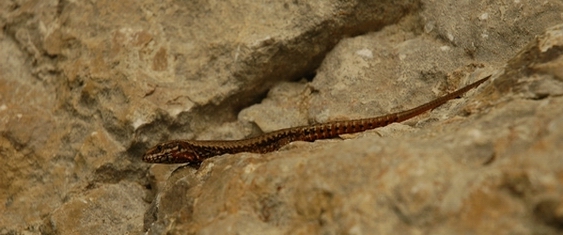SpeleologyThe limestone ridge of Buila-V├ónturari┼úa Massif, due to its south-west to north-east direction, represents a barrier for the rivers that collect the waters of the southern slopes of the C─âp─â┼ú├ónii Mountains. Rivers, having to go around the central area, managed to pass through this barrier only at the two ends: in south-west the rivers Bistri┼úa and Coste┼čti carved a spectacular gorge where Mount Arnota is also comprised, and in the north-east, rivers Cheia and Ol─âne┼čti carved Comarnicelor Gorge (also called Recea Gorge or Cheii Gorge), one of the deepest and wildest in the country, with 1 km of waterfalls, erosional holes, steps, walls as narrow as 2 m and as tall as 300 m, and respectively M├ónzului Gorge (Ol─âne┼čtilor Gorge, Folea Gorge, the Bad Valley or the Dry River Gorge). Beside the gorge, the exokarst is poor in numbers, variety and dimensions, because of the structure of the limestones. There is the limestone blocks field in Mount Albu, a few natural arcades, like the House of Stone above P─âtrunsa Monastery is the mostly known, the horns at Curm─âtura Builei and the north-western slope. The endokarst are much better represented, by over 100 caves and a few vertical caves. Beside the gorges, the exokarst is poor in numbers, variety and dimensions, because of the structure of the limestones. There is the limestone bloks field in Mount Albu, a few natural arcades, like the House of Stone above P─âtrunsa Monastery is the mostly known, the horns at Curm─âtura Builei and the north-western slope. The endokarst are much better represented, by over 100 caves and a few vertical caves. Buila-V├ónturari┼úa Massif is the furthest east in the Middle Carpathians that fosters a caving micro fauna. For that reason and because of the large number of caving micro fauna species, the massif is very important under the biospeleontological aspect. Buila-V├ónturari┼úa Massif is the furthest east in the Middle Carpathians that fosters a caving micro fauna. For that reason and because of the large number of caving micro fauna species, the massif is very important under the biospeleontological aspect. Ten of the park's caves are natural protected areas by Low no. 5/2000:
|

 |
|
 |
||||||||||







